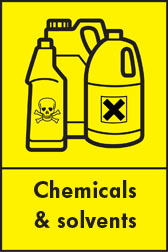Hazardous Waste Premises Codes
Hazardous Waste Premise Codes
Due to changes in the Hazardous Waste Regulations, the University is no longer required to register premises/buildings that produce hazardous waste with the Environment Agency.
However, the Regulations do still require a Hazardous Waste Consignment Note to accompany any hazardous waste movement, and of 1st April 2016 the first 6 characters of the Consignment Note Code for any wastes moved from University premises should be “UNIVER” followed by 5 characters unique to each individual waste movement (rather than the “premise code” that was used as the consignment note code before 1st April 2016).
Further information on this subject can be found at https://www.gov.uk/guidance/hazardous-waste-consignment-note-supplementary-guidance
Any contractors working on projects who are removing hazardous waste as part of that project can use the “UNIVER” characters followed by their own unique 5 characters unless they wish to use their own business name for the first part of the code.
It is no longer a legal requirement to record a “premise” code for individual buildings on the Consignment Note.
The new Hazardous Waste Consignment Note can be found at the following link - https://www.gov.uk/government/publications/hazardous-waste-consignment-note.
What is hazardous waste
Some types of waste are harmful to human health, or to the environment, either immediately or over an extended period of time. This is called hazardous waste.
Many items are classed as hazardous waste because of the substances they contain and as such require appropriate disposal, separate from normal waste disposal routes.
The University produces numerous types of hazardous waste and has a 'duty of care' to make sure it's disposed of properly. Currently, individual Schools/Faculties make their own disposal arrangements for most hazardous wastes.
Any hazardous wastes produced by activities in the Directorate of Estates and facilities are managed by the University’s Waste Co-ordinator, Simon Atkinson (x65963), who can also provide advice on the hazardous waste regulations and how to dispose of hazardous wastes properly.
The classification of many hazardous waste can be complex but the Environment Agency has various guidance available to help.
More detailed guidance on hazardous waste, known as WM3 guidance, is available here.
Although many wastes will be hazardous depending on the concentration of harmful substances they contain, others will always be classed as hazardous, such as the following:
- Waste mineral oils
- Wastes containing asbestos
- Fluorescent tubes
- Fridges/freezers
- Monitors/TVs containing cathode ray tubes
- Items containing mercury (e.g. thermometers)
It is a criminal offence to dispose of any hazardous wastes inappropriately. The above items should never be disposed of in the general waste otherwise the University, or the individual involved, may be subject to prosecution by the Environment Agency.
Moving hazardous waste
With very few exceptions, a consignment note must be completed to accompany hazardous waste when it is moved from any premises. The Environment Agency has a number of guidance notes relating to consignment notes for moving hazardous wastes.
It is a legal requirement for any producer of hazardous waste to keep copies of consignment notes for at least 3 years on a register that may be inspected at any time by the Environment Agency.
The records/registers of any hazardous wastes produced by operations in the Directorate of Estates and Facilities are kept by the University’s Waste Co-ordinator, Simon Atkinson (x65963). Individual Schools/Faculties producing their own hazardous waste should also keep relevant records for 3 years.
Record keeping: moving or receiving hazardous waste
You must maintain records in a register, of each waste involved, if you are involved in the movement of hazardous waste. This includes:
- its removal from your premises
- transport
- intermediate storage
- disposal or recovery
Record keeping: disposal or recovery of hazardous waste
You must also maintain records where hazardous waste is disposed, or recovered, at the same site as its production or storage.
As a producer, consignor, holder, carrier or consignee you need to:
- keep records in a register of hazardous waste movements
- supply specified information to the Environment Agency, or emergency services, as required

